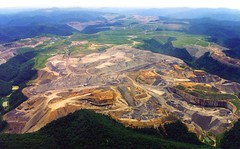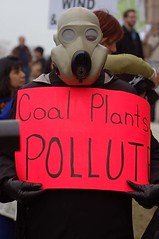 us as individuals, to eliminate coal-electricity pollution from fly ash, mercury, CO2, etc? What value should be placed on stopping mountain-top removal?
us as individuals, to eliminate coal-electricity pollution from fly ash, mercury, CO2, etc? What value should be placed on stopping mountain-top removal?Murray has coal in his blood and has worked his way up the ladder to be CEO (and owner) of a $260+ million/year corporation.
And, he is a battler, sadly for the wrong causes.
The Coal Industry Speaks
Murray's confrontational stand outside the Crandall Canyon mine is just one more battle in a war he has been waging in defense of an industry he believes is unjustly vilified. In the past year, Murray has emerged as one of coal's most ardent defenders against charges that it is driving global warming, arguing on Capitol Hill and in interviews that restricting coal would decimate the U.S. economy.
"I know what's going to happen to families . . . and I cannot sit back and let it happen," Murray said in a lengthy interview ... earlier this summer. "I'm an American first, and I resent extremely that what you are doing is destroying the American economy and causing the deterioration of the American way of life."
 the charges against coal are quite serious: fly ash is a serious pollution, coal-fired electricity pollution causes illnesses, is a major cause of mercury that has gotten throughout the economy and (for example) creates dietary guidance limiting tuna eating, and is the key single-point CO2 contributor around the globe.
the charges against coal are quite serious: fly ash is a serious pollution, coal-fired electricity pollution causes illnesses, is a major cause of mercury that has gotten throughout the economy and (for example) creates dietary guidance limiting tuna eating, and is the key single-point CO2 contributor around the globe.On Tuesday, he used the spotlight to deliver a general paean to coal, with harsh warnings of a sort that many economists have challenged: "Without coal to manufacture our electricity, our products will not compete in the global marketplace against foreign countries because our manufacturers depend on coal for low-cost electricity, and people on fixed incomes will not be able to pay for their electric bills," he said. "Every one of these global warming bills that has been introduced in Congress today will eliminate the coal industry and increase your electric rates four- to fivefold."
And, what did The Washington Post do in this very long story? Did they question Murray's assertions, providing an alternative perspective to aid their readership in judging his comments? No. They were left unchallenged, as if they were fact. Actually, it is not that they were unchallenged, they were uncorrected.
Electricity Prices
Let us start with electricity prices. If we were to phase out coal over the next several decades (as we should, let us be clear): What are the options? what are the prices? Would we freeze in the dark as Murray suggests?
Even in terms of direct costs, new coal generation plants cost roughly the same, per kilowatt generating capacity, to build as wind turbine farms. Yet, the wind farm does not need to pay for any coal. Geothermal is cost competitive with coal. (For examples on this, see table 39, Cost and Performance Characteristics of New Central Station Electricity Generating Technologies in this DOE report. See also Relative Costs of Electricity Generation Technologies from the Canadian Energy Research Institute). The Institute for Energy and Environmental Research provides these figures:
* Coal-fired: 3.5 to 4 cents per kilowatt-hour
* Natural-gas, combined cycle: 5 to 6 cents per kilowatt-hour
* Nuclear: 5.5 to 6.5 cents per kilowatt-hour
* Wind in favorable areas and up to 20 percent of the supply: 4 to 5 cents per kilowatt-hour
* Solar: roughly 20 cents per kilowatt-hour (without energy storage)
And, well, so on ... do we need 50 sources?
Hmmm ... if we were talking about replacing all coal with photovolaiic solar, which costs four times the cost of coal, we would see not a 4-5 times increase of per kilowatt hour rates but maybe 2.5-3.0 increase as coal provides 50% of today's electricity. But, we will not replace coal with today's solar, but with a mix of renewable energy sources and massive amounts of energy efficiency (and, of course, Negawatts come in cheaper than that new coal-electricity anyway).
Thinking past Electricity Rates
But are "rates" (per kilowatt hour costs) what we should focus on? California has high electric rates but electricity use per capita has remained flat for 30 years while the rest of America saw sixty percent increases in use.
California is a leader in the area of demand side management. Beginning in the 1970's the state enacted energy efficient building code policies and numerous financial and other incentives to reduce electricity use. The effect of California's energy efficiency programmes is pronounced. Per capita electricity use in California has remained practically unchanged since the mid-1970s, compared to a growth in national per capita electricity use of about 1.5% per year.
Why? Is it because they are sleeping in the dark? Because there are no big-screen TVs in Hollywood, computers in Silicon Valley, and Valley Girls don't have cell phones to recharge? Why? Because California invested in energy efficiency so its citizens pay less on their total bill even if they pay more per kilowatt.
*"Externalities": Considering those other costs*
Well, what about those nasty externalities, moving the discussion from the cost to buy coal electricity to society's cost to own it? How much is it worth to society, to  us as individuals, to eliminate coal-electricity pollution from fly ash, mercury, CO2, etc? What value should be placed on stopping mountain-top removal?
us as individuals, to eliminate coal-electricity pollution from fly ash, mercury, CO2, etc? What value should be placed on stopping mountain-top removal?
And, guess what, this can be done at a 'profit'. With an enriched economy. Energize America provides a holistic concept how to get there. California, which has flat electricity per capita use for 30+ years with a booming economy, shows that it can occur in the real world. As per one case study of "low carb" solutions:
With a population of 35 million, and a $1.3 trillion dollar economy, California would rank in the G7 group of largest OECD economies if it were a nation. Yet in terms of carbon intensity ... Californians' average annual per capita greenhouse gas emissions are 12.2 tonnes, while the average for the US as a whole is 20 tonnes. This lower emissions intensity is partly due to the fortunes of geography - the state is legendary for its mild weather, but California has also been proactive.Since the early 1970s California has been a leader in promoting energy efficiency and cleaner fuels. ... number of significant energy efficiency and renewable power policies.
Parroting Senator Inhofe (R-Exxon)
Sadly, The Washington Post did not see fit to challenge Murray, to show how Murray's playing to the fear factor was, to be generous, not truthful. According to Murray, we cannot act on Global Warming or we'll live in the the dark. To paraphrase Senator Inhofe, 'this might be the greatest hoax ever played on the American public.'
Ask yourself:
Are you doing
your part to
ENERGIZE AMERICA?Are you ready
to do your part?Your voice can
... and will make a difference.So ... SPEAK UP ... NOW!!!
* Version orginally posted at Energy Smart.